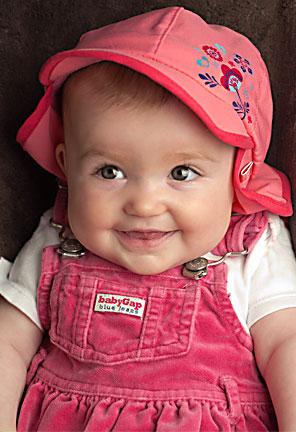
THE BOOK REVIEW AND PHOTO ESSAY
As may be for many of you, my husband and I had the extreme privilege of welcoming our daughter into the world. She was born a healthy more-than-full-term baby, and I had the honor of staying at home with her for the first four months. I found myself experiencing a whole new kind of lifestyle, vastly different from the student, teacher, or world traveler roles of my recent past. I was at home almost every day, all day, celebrating the days that I took a shower, got dressed into something other than sweatpants, or made it outside on an outing. The few days when all three of the above would happen, were quite frankly a miracle. In between holding and nursing a newborn, and taking naps of my own, I found myself organizing the hundreds of photographs I’d taken of my new bundle of love. I was disgusted with what I had. What happened to the BFA photography graduate who had such a critical sense of composition and photography techniques? Had I lost it all? No longer was I an expert on contemporary photography perspectives.
I can’t blame it entirely on my new identity as a mom. It started years ago when I became an elementary art teacher. My current career has trapped me in a world where we research the latest news on standardized testing and its role on art education or the decreasing money available for our supply budgets, instead of furthering our own artistic skills. Now I was thinking about milk supply and sleep deprivation. Yes, I had lost touch with my once passionate obsession of creating fine art photography
But now that I had the most perfect subject (Baby A) who was available 24/7, I should be making priceless, eye-catching images, right? Well, it wasn’t happening, as if I already didn’t have enough to make me think my life as an artist was over. Then I started doing some book reviews for Apogee Photo Magazine of the latest books that were coming out. This started to get my hopes up. I found one book in particular that got my creative juices flowing again: Beyond Snapshots, by Rachel Devine and Peta Mazey. At first I thought this was like many other amateur photography how-to books that we often get in the mail to review for the magazine. But this book ended up being the inspiration for revitalizing my inner photographer. My background in photography was using film and the darkroom. Nothing in digital photography has quite sparked my creative interests, except maybe the book Camera Creative by Chris Gatcum. Digital photography can be just as creatively stimulating as traditional photographic techniques like alternative process, and can even be used to your advantage as a photographing parent.
Beyond Snapshots: How to Take That Fancy DSLR Camera Off “Auto” and Photograph Your Life like a Pro
by Rachel Devine & Peta Mazey
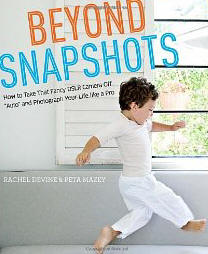
The first part of the book that helped me revitalize my photography skills was the first chapter, titled Pick Up Your Camera, which talks about using your DSLR camera. One of the new skills I needed to work on, as someone who was more familiar with film cameras, was being able to change the ISO from image to image. This feature, on a high quality camera, is wonderful. Normally, photographing indoors creates such a low light setting that you either need to use a flash or a tripod. Neither option is fun when you’re trying to take candid and artful photographs. So, having the ability to set your camera to 800 ISO and not get a ridiculous amount of grain/noise, is quite exhilarating. Something else to keep in mind, is that your camera has a Priority mode, which the authors nicknamed partially auto or training wheels. For those who don’t want to set their camera completely to manual, this setting (as well as aperture and shutter priority) works great. You can let the camera find the correct exposure, but then move the shutter or aperture according to your compositional needs and the camera will adjust for a correct exposure. To me, what often makes a good photograph GREAT, is the lighting. Chapter 2, Get to Know the Light helps with that, even if it’s just a few reminders about using the light you have to your advantage. Another reminder that Devine and Mazey give is that what is technically considered ‘wrong,’ can sometimes be artistically perfect. My theory in learning an artistic medium is that you learn the rules and then you can experiment on breaking them.
“Before you can think out of the box, you have to start with a box.” > Twyla Tharp (1941- )
Workflow is something I wanted to do from the start. I knew I’d being taking a million and a half photographs of my new baby girl, so I wanted to start with a system, instead of planning to go back later. Nobody does. Ok, not in their right mind, they don’t. I decided that I was about to document the life of a new human being, and that everybody says it goes fast and there are lots of milestones along the way. So what seemed logical for me, was using the date the image was created. After I download a set of photos from my camera, I rename all the files “Baby Name year-month-day ##” and then they are saved in nested folders by date (2012 has a folder for every month). I also thought with all the exchanges of family photos, there would be a time when someone (possibly myself) would want to know the age of a particular photo or want to be able to find a particular photo and I thought it would make sense to have that info within the filename. Some people (my husband included) think this is redundant, since the created date is in the metadata (that personal file that’s kept on every individual photograph). It just depends on what works for you. The key is keeping to the plan. So, make sure it works for you and then stick to it.
Now for the projects. My favorite part of this book is Part 2: Life Is a Photo Op. Just the title of the section lets you know what these two author/photographers are trying to get across in their books. They have some great ideas for you to take photos of everyday life. For this article, I’m going to focus on a project in the Documenting Family Life chapter and it is about using photography to do A Day in the Life of your family. This is an old idea, but I like their approach. I took photos of Baby A’s typical day this summer, when she was about 6 months old.
Take a look and keep in mind, whether it’s a new baby, mom and dad, other family members, or friends, documentation and creating a workflow still applies. START WITH THAT BOX!
Click Here to view each image with technical data and comments.
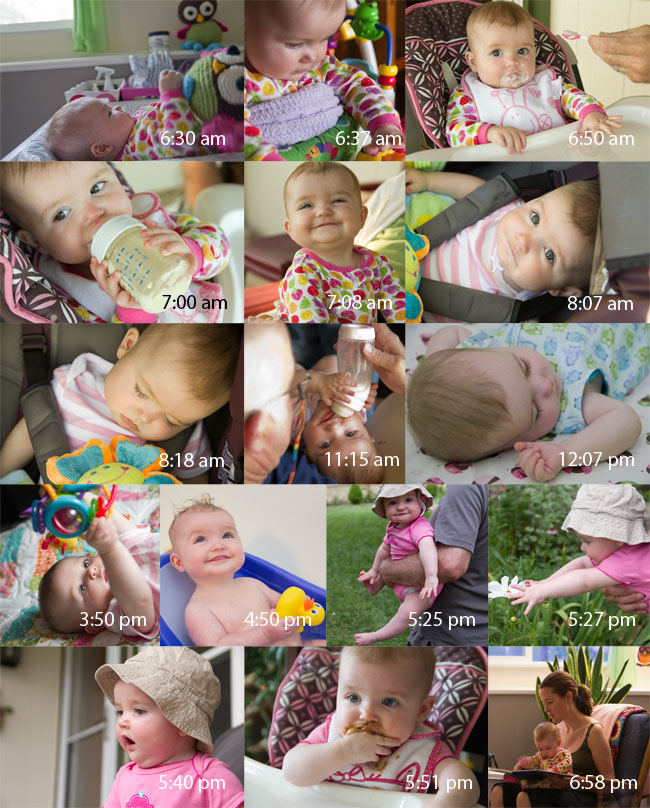
The Book:
Publisher: Amphoto Books; Original edition (March 20, 2012)
Language: English
ISBN-10: 0817435808
ISBN-13: 978-0817435806
User: All Amateur Photographers and Photographers wanting a creative boost
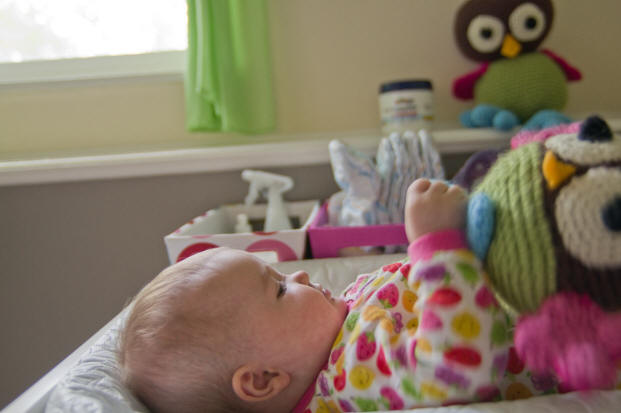
Pentax K-5, 16-50mm lens at 26mm, ISO 800, f2.8 for 1/15 sec
This picture, taken early in the morning, presented a number of challenges. First, it is backlit. The morning light coming through the window is much stronger than the ambient light of the room. This is tricky, because your camera’s meter will try to take the light from the window and adjust the exposure. The result will be a foreground that is way too dark. To get around this you need to make sure that you are metering the foreground without the window. You can accomplish this by getting in really close to the subject so that there is no window showing in the viewfinder, and setting your AE lock to lock in the exposure. You can then reframe and refocus and shoot the picture. If you don’t know how to use this function, check your manual as every camera is a little different.
Another method is to use your AE compensation to cause the camera to overexpose the scene when you frame it exactly like I have it here. You may need to take a few shots setting the camera to +1 or +2 stops until you get the balance you want. Again every camera does this slightly differently, so if you are unsure check your manual.
The light was very dim this early in the baby’s room. If I had my camera set to “AUTO”, my camera may have fired the flash to make a correct exposure. You want to make sure this does not happen. Remember, the book is about getting your camera off of AUTO. In all of these pictures and when I shoot low light photos in general, I try to avoid using flash. Flash is a very artificial looking light, causing a flat and harsh looking image. If you can’t use a tripod, and who can when shooting a baby, try bracing your camera against a piece of furniture, or a door or wall; I used the crib. To make sure I didn’t end up with a ridiculously long exposure which would have resulted in a blurry picture, I chose to up my ISO to 800. I used to avoid doing this because older cameras introduced a lot of noise when you raised the ISO. But newer cameras do an excellent job of producing an image at higher ISO’s without too much noise.
Lastly I recommend that you shoot in RAW mode as I have done in this series of images. Being able to edit the RAW image allows me to get an image that is exactly the way I want it.
6:37 a.m.
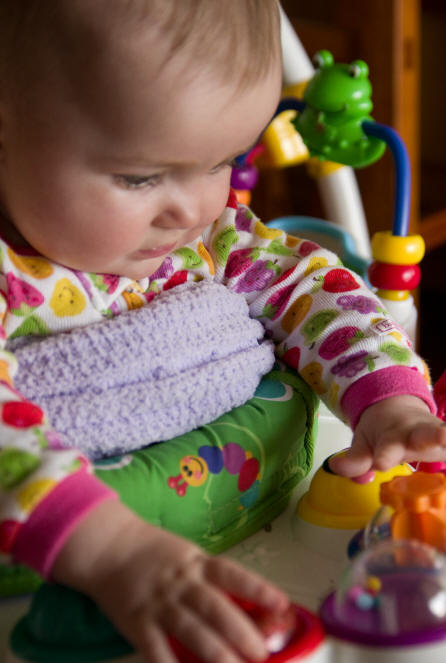
Pentax K-5, 16-50mm lens at 50mm, ISO 800, f4 for 1/60 sec
This jumpy thing (still learning the language of the baby toys) usually sits in a pretty dark area of the house. I could have opened my flash and got an image with an accurate exposure, but as I talked about in the previous image, I didn’t want the look that the flash creates. I wanted to show Baby A playing in the morning light, something she does every morning while breakfast is being made. So I moved the jumpy thing over to the glass storm door where all the light comes through in the morning. This gave me such wonderful light that I was able to use a relatively high shutter speed and therefore hand-hold the camera. A bigger aperture created a shallow depth of field making the viewer’s eye focus in on her little world.
6:50 a.m.
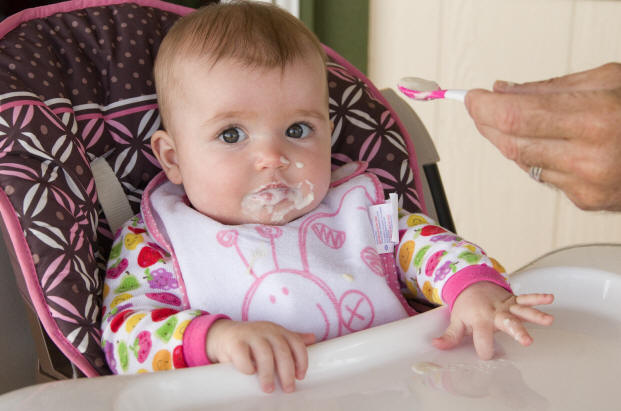
Pentax K-5, 16-50mm lens at 50mm, ISO 800, f/6.3 for 1/320 sec
This photo was actually taken outside. We eat breakfast outside because of the wonderful temperature in the mornings. This created a situation where I could use a much higher shutter speed and not get blur with the fast motion of her hands.
7:00 a.m.
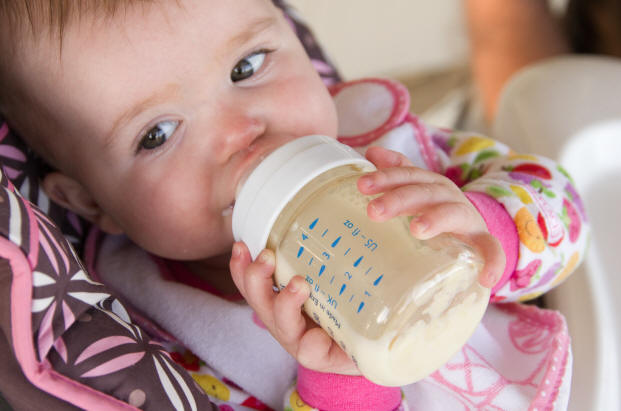
Pentax K-5, 16-50mm lens at 50mm, ISO 800, f/6.5 for 1/250 sec
Try different perspectives when you’re photographing your kids. The tendency is to always shoot while looking directly at them in front of you (such as the previous shot), but take advantage of their curiosity to watch what you’re doing. I stood next to Baby A and looked down at her and when she turned her head and body to look at me, something else caught her eye, creating this interesting pose. I was also taking advantage of the moments when she feels in control of her life. This is when you can focus on the camera and she can just be cute.
7:08 a.m.
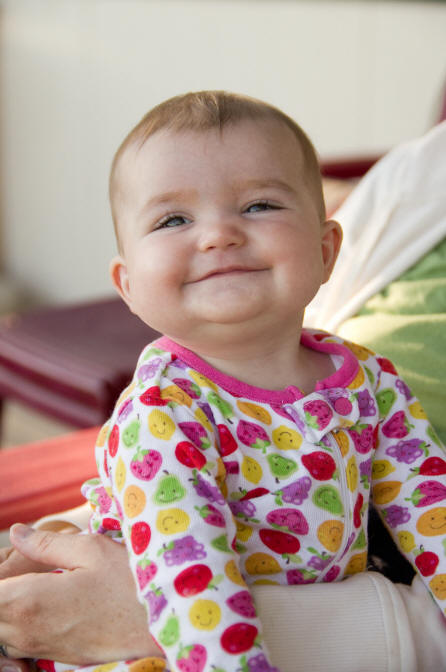
Pentax K-5, 16-50mm lens at 26mm, ISO 800, f/3.5 for 1/1250 sec
Another good time to photograph kids is when their tummies are full. This is right after Baby A finished her breakfast. She is ready for the day!
8:07 a.m.
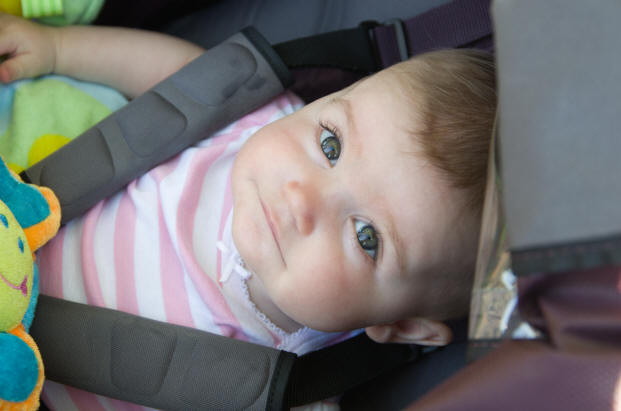
Pentax K-5, 16-50mm lens at 50mm, ISO 200, f/4.5 for 1/200 sec
This photo of Baby A in the stroller was taken at ISO 200, but notice how I’m still able to shoot at 1/200 of a second in the shade. Once you start photographing outside during the day, you’ll want to take your camera’s ISO setting down so that you can optimize the image quality. There is A LOT more light outside, even in the shade. Again, I’m taking advantage of her curiosity and not just pointing my camera directly at the front of her.
8:18 a.m.
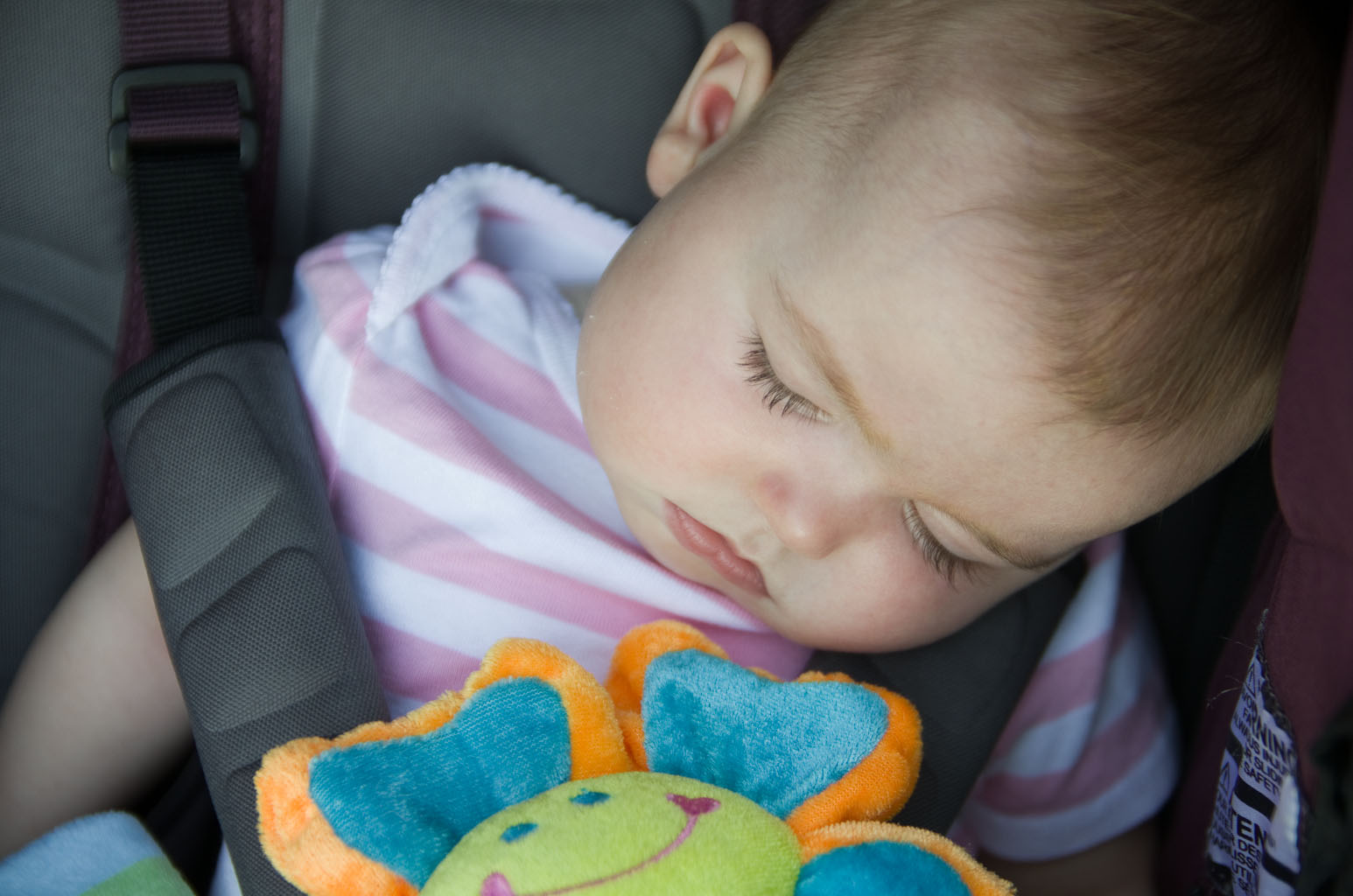
Pentax K-5, 16-50mm lens at 50mm, ISO 200, f/3.2 for 1/250 sec
Sometimes you have to go back to photographing directly at the front of your subjects, because they’re not always going to turn to look at you. To make this image more interesting, I used the rule of thirds, putting the area of interest (her face) off of center.
11:15 a.m.
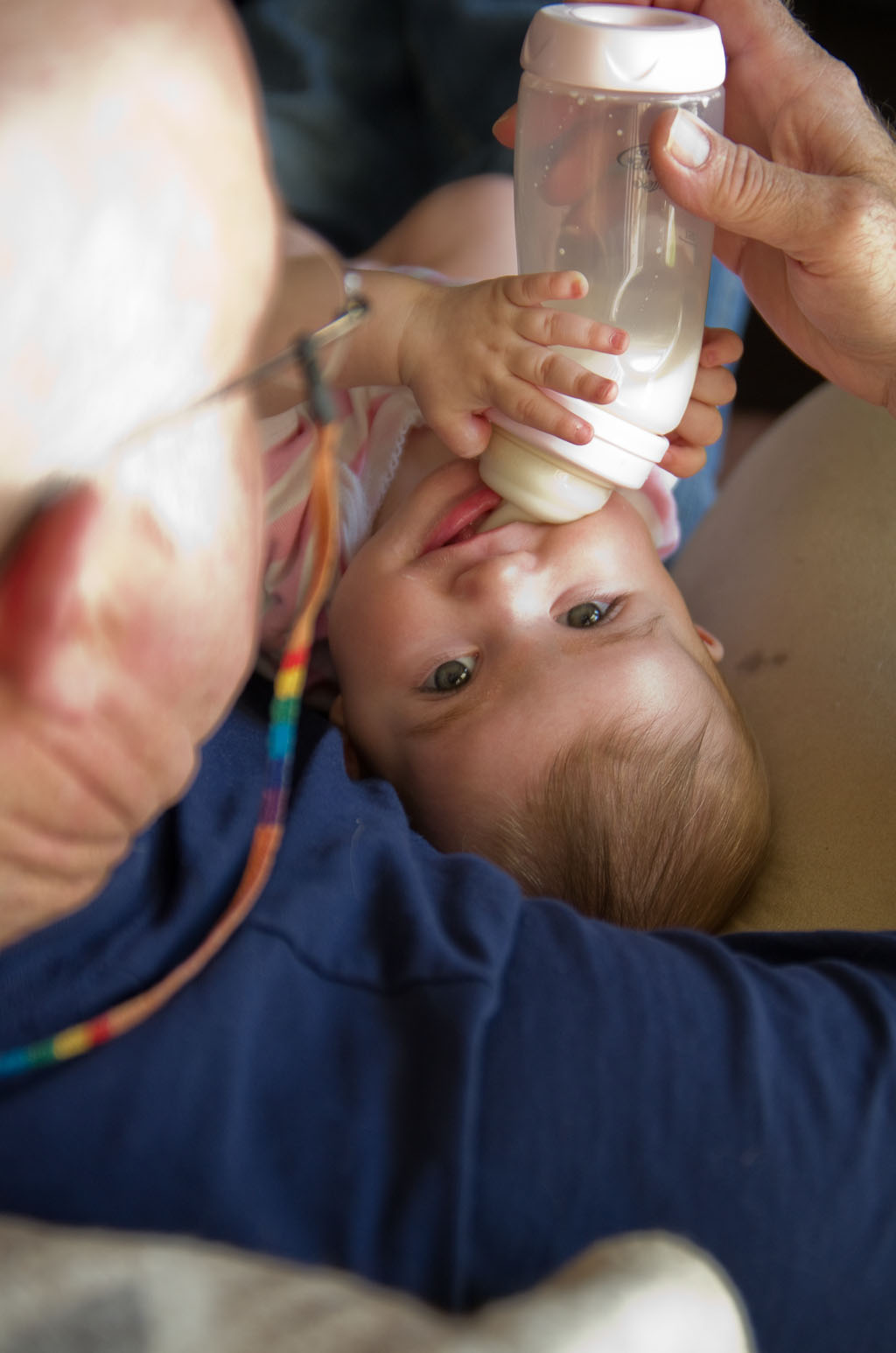
Pentax K-5, 16-50mm lens at 50mm, ISO 800, f/2.8 for 1/60 sec
Baby A is still learning to hold her bottle, so she isn’t always independent with this activity. That doesn’t mean I can’t get a good photo of the event. I think she’s getting the idea that being the subject of Mommy’s photo is going to last for a while.
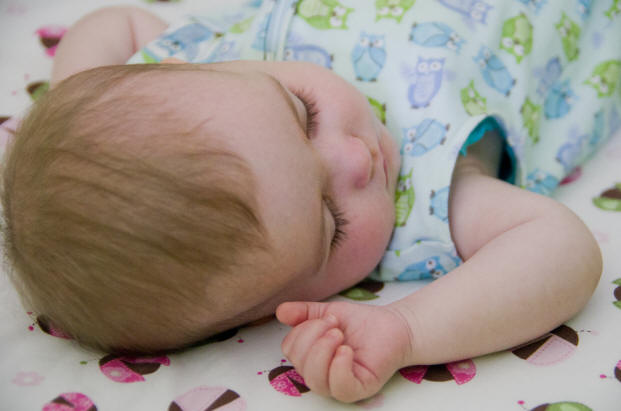
Pentax K-5, 16-50mm lens at 43mm, ISO 800, f/2.8 for 1/40 sec
This photograph was not shot with a correct exposure, but luckily I shot it in RAW and could use an image editing program to do some post processing that didn’t degrade the image too drastically. I could never make a 20×30″ print for the wall, but that was not the intent. Not all your photos have to be perfect; they can often be saved to at least worthy enough quality that you’re glad the moment was documented. Keep that in mind, and don’t beat yourself up. I know, it’s hard for me, too!
3:50 p.m.
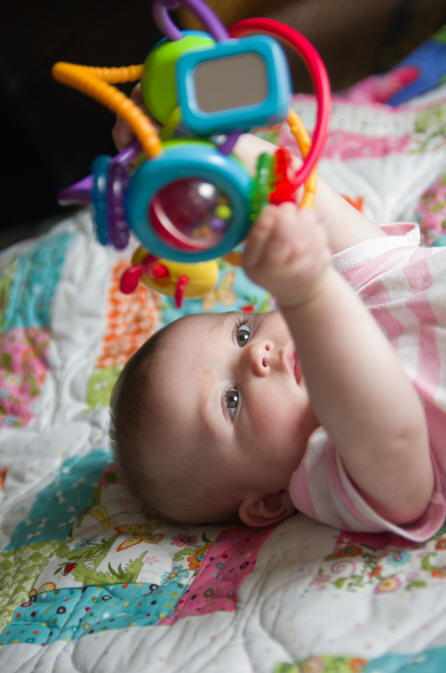
Pentax K-5, 16-50mm lens at 50mm, ISO 800, f/3.2 for 1/60 sec
Here’s another example of how I took advantage of the available light. Indoor light is VERY DARK, even though it doesn’t always seem like it when our eyes have adjusted. I moved the quilt on the floor right up to the window so I could get as much light as possible on Baby A and the quilt. The low light in the back of the room made the dark furniture even darker, therefore causing it to be the opposite of a distraction. This brighter lighting situation, high ISO setting, and my desire to use a wide open shutter made it possible to use a high enough shutter speed that I could hand-hold the camera. Being able to hold the camera with your hands and not get out a tripod is so helpful when you’re photographing kids and moving around on the floor. Here’s another example of how I took advantage of the available light. Indoor light is VERY DARK, even though it doesn’t always seem like it when our eyes have adjusted. I moved the quilt on the floor right up to the window so I could get as much light as possible on Baby A and the quilt. The low light in the back of the room made the dark furniture even darker, therefore causing it to be the opposite of a distraction. This brighter lighting situation, high ISO setting, and my desire to use a wide open shutter made it possible to use a high enough shutter speed that I could hand-hold the camera. Being able to hold the camera with your hands and not get out a tripod is so helpful when you’re photographing kids and moving around on the floor.
4:50 p.m.
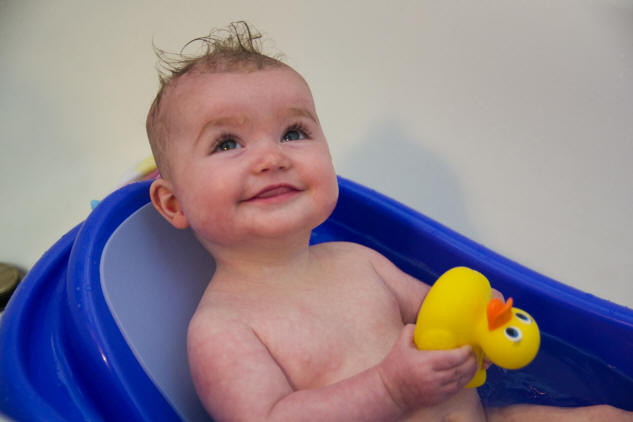
Pentax K-5, 16-50mm lens at 39mm, ISO 800, f/2.8 for 1/60 sec
Oh, bath time. This was the first time she actually enjoyed bath time. I got out the long forgotten rubber ducky gifts and that made a world of difference. So lesson learned: give your child something to interact with if you want to have your hands free to take photos. PLEASE BE SAFE while photographing your child in water! I set up before hand a quick, easy, and safe spot for my camera so that I didn’t have to think about its needs above my child’s needs. I could very easily set my camera down when necessary and therefore still have my focus on my child’s safety at all times. Always have everything prepared and ready right next to the bath so you don’t have the desire to run and grab something real quick. If you forgot to put the memory card in the camera and the child is already in the bath water, DO NOT go run and get the memory card “real quick.” There will be plenty of other bath times, or hire an assistant (hello hubby!)
As far as lighting, this image was originally too dark so the exposure had to be increased in post processing. I later found in the book a great suggestion of using the kitchen sink where there is often better lighting. The kitchen sink doesn’t have to only be a place to bathe a newborn, older babies and toddlers look adorable sitting in the sink.
5:25 p.m.
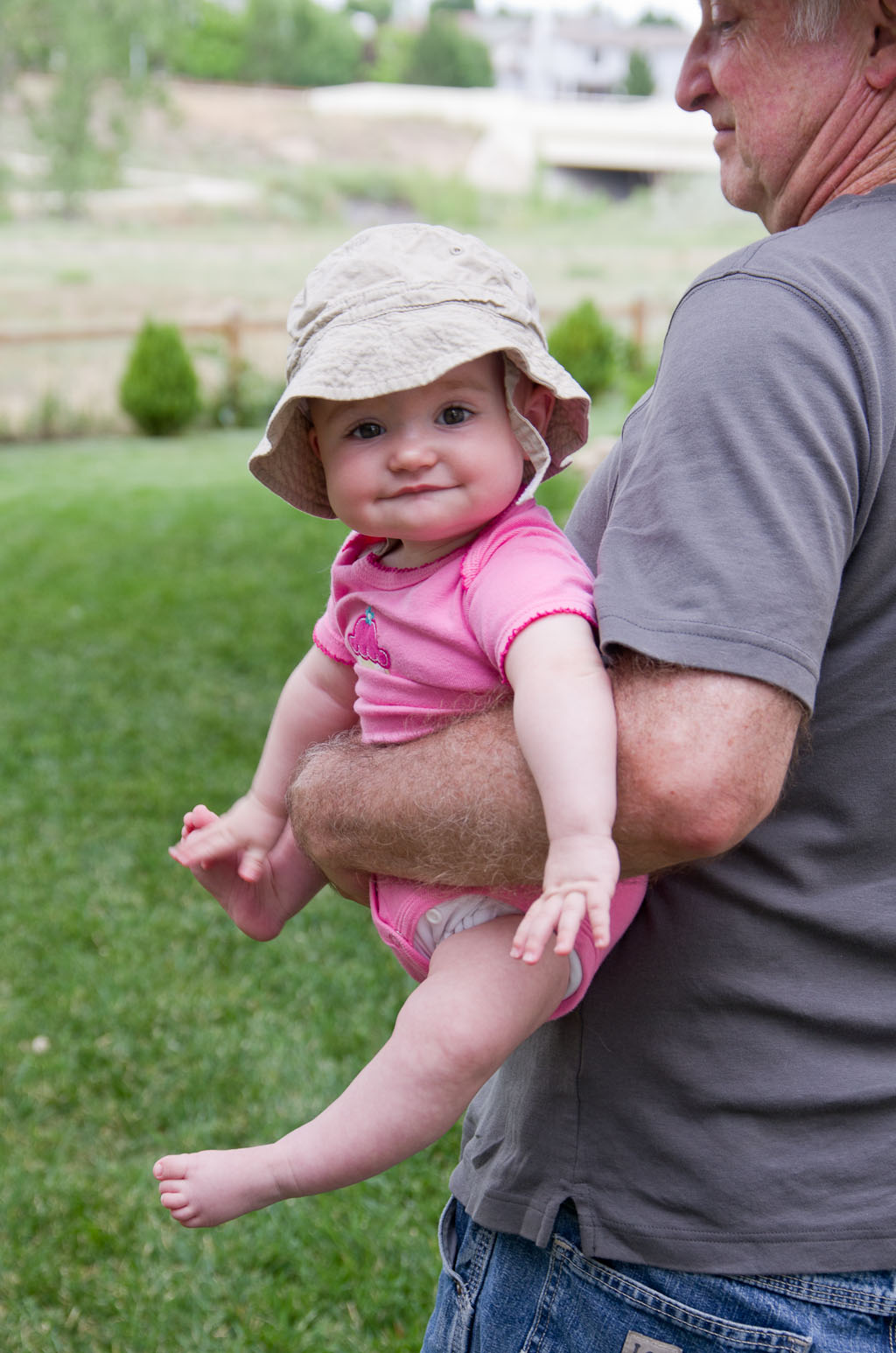
Pentax K-5, 16-50mm lens at 50mm, ISO 200, f/5 for 1/100 sec
I love evening light. It’s still relatively bright outside (you can use both a lower ISO and a higher shutter speed) and the light is more even making it more flattering and easier to expose. “Walking the kingdom” with Daddy is a daily ritual in the evenings, where they take note of all the changes in the garden.
5:27 p.m.
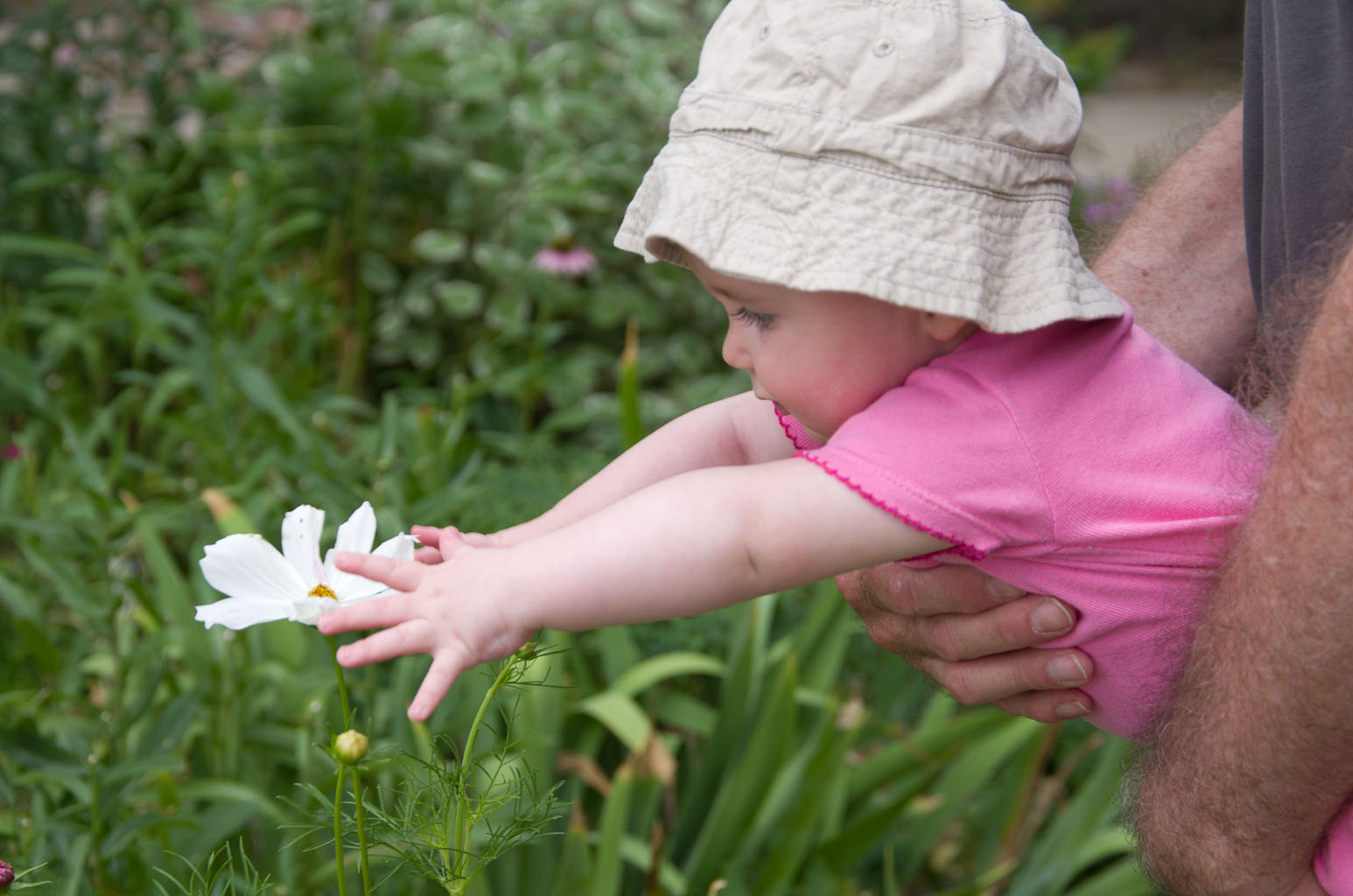
Pentax K-5, 16-50mm lens at 50mm, ISO 200, f/5 for 1/100 sec
I said previously that it is often helpful to give your child something to interact with, such as a rubber ducky in the bathtub. But it doesn’t always have to be something that is the typical toy for a child. Letting them interact with their environment isn’t only good for their development, it makes a nice photograph. Baby A absolutely LOVES flowers.
5:40 p.m.
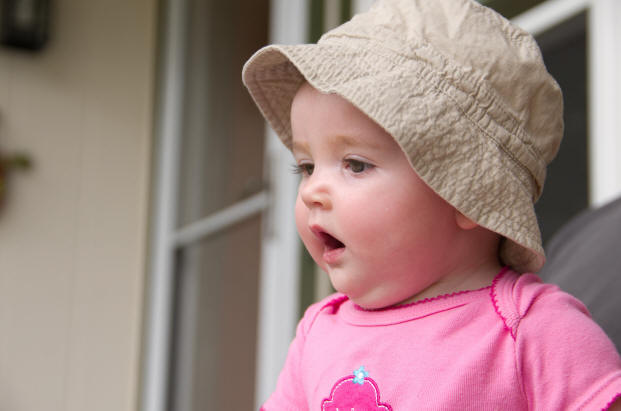
Pentax K-5, 16-50mm lens at 50mm, ISO 200, f/5 for 1/100 sec
The fun part about doing a photography Day in the Life of Baby is that the images don’t have to be the stand alone, traditional shots made for framing. Instead, focus on telling a story. Try your best to avoid the look at my baby pose perfectly and smile in all these places and times images. But instead, focus on telling how your child changes throughout the day.
5:51 p.m.
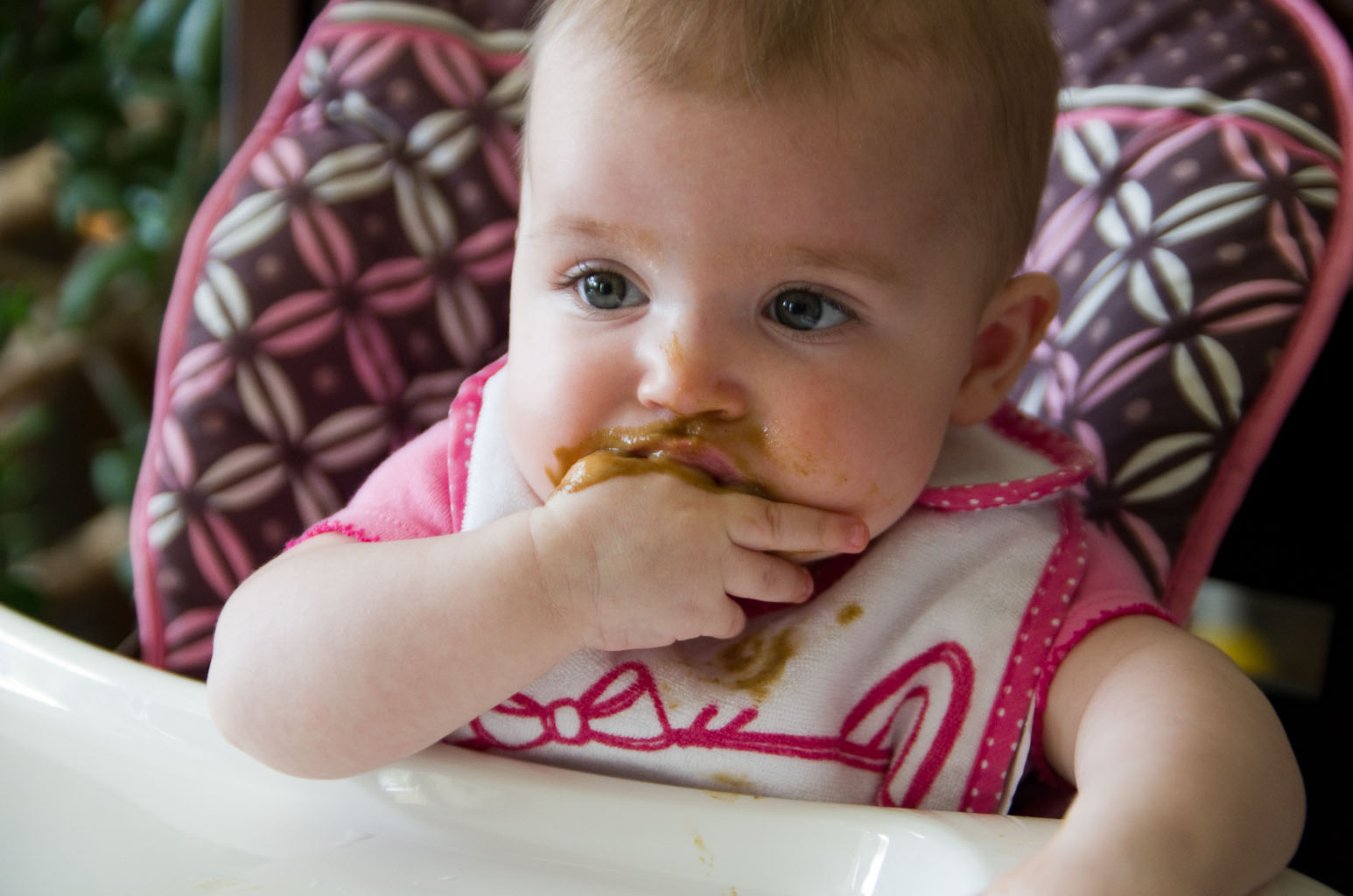
Pentax K-5, 16-50mm lens at 50mm, ISO 800, f/2.8 for 1/100 sec
This was one of the first few times Baby A tasted solid food. She was getting to the “blank stare” phase of being tired, but still curious about exploring these new textures. She did not want to sit and just be spoon fed; she wanted to participate. In this image the light is coming from a west facing window. So again, take advantage of the natural available light.
6:58 p.m.
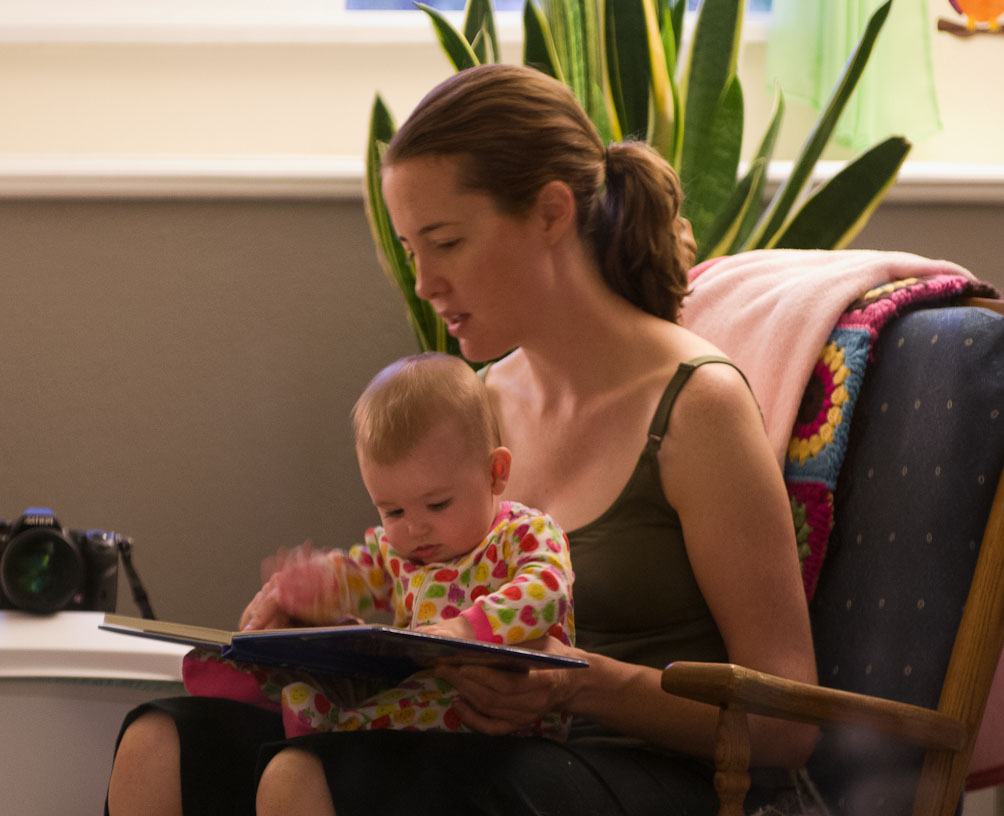
Pentax K-5, 16-50mm lens at 26mm, ISO 1600, f/2.8 for 1/15 sec
Just because your role is the photographer, doesn’t mean that you aren’t an important part of your child’s life and shouldn’t be documented. Although you can ask friends and family to help do this for you, using the self timer on your camera and/or mirrors is kind of fun. The camera is sitting on the diaper bin in the left of the image where I can easily get to it. It is pointing to the opposite side of the room where there are full length, closet mirror doors. So, this is actually a photograph of us in the mirror. The diaper pail acts as a tripod to stabilize camera shake, but again I like how you can see Baby A’s excitement about the book through her blurred motions. There is noticeable grain (noise) in this image, but look at the ISO setting. Not bad for 1600!
Now go enjoy the fun yourself and document away…
By Elizabeth Powis Fulks
Article and photos: © 2012 Elizabeth Powis Fulks . All rights reserved.

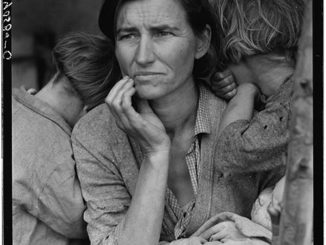
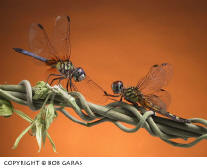

Leave a Reply